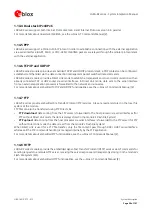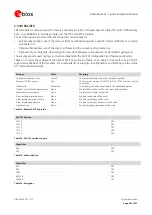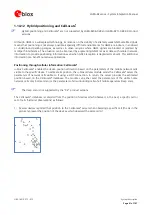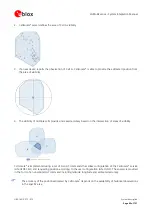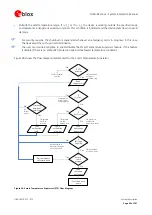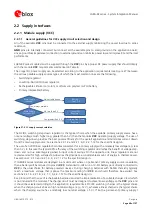
LARA-R2 series - System Integration Manual
UBX-16010573 - R12
Design-in
Page 72 of 157
2.2.1.3
Guidelines for VCC supply circuit design using a Low Drop-Out (LDO) linear regulator
The use of a linear regulator is suggested when the difference from the available supply rail and the
VCC
value is
low: linear regulators provide high efficiency when transforming a 5 V supply to a voltage value within the module
VCC
normal operating range.
The characteristics of the LDO linear regulator connected to the
VCC
pins should meet the following prerequisites
to comply with the module’s
VCC
requirements summarized in Table 6:
Power capabilities
: the LDO linear regulator with its output circuit must be capable of providing a voltage
value to the
VCC
pins within the specified operating range and must be capable of delivering the maximum
peak / pulse current consumption to the
VCC
pins during a Tx burst at the maximum Tx power specified in
the
LARA-R2 series
Power dissipation
: the power handling capability of the LDO linear regulator must be checked to limit its
junction temperature to the maximum rated operating range (i.e. check the voltage drop from the max input
voltage to the min output voltage to evaluate the power dissipation of the regulator).
Output voltage slope
: the use of the soft start function provided by some voltage regulators should be
evaluated carefully, as the
VCC
voltage must ramp from 2.3 V to 2.8 V in less than 4 ms to switch on the
module by applying the
VCC
supply. The module can be otherwise switched on by forcing a low level on the
RESET_N
pin during the
VCC
rising edge and then releasing the
RESET_N
pin when the
VCC
supply voltage
stabilizes at its proper nominal value.
Figure 30 and the components listed in Table 22 show an example of a high reliability power supply circuit, where
the
VCC
module supply is provided by an LDO linear regulator which is capable of delivering the specified highest
peak / pulse current, with the proper power handling capability. The regulator described in this example supports
a wide input voltage range, and it includes internal circuitry for reverse battery protection, current limiting, thermal
limiting and reverse current protection.
It is recommended to configure the LDO linear regulator to generate a voltage supply value slightly below the
maximum limit of the module
VCC
normal operating range (e.g. ~4.1 V as in the circuit described in Figure 30 and
Table 22). This reduces the power on the linear regulator and improves the whole thermal design of the supply
circuit.
5V
C1
IN
OUT
ADJ
GND
1
2
4
5
3
C2
R1
R2
U1
SHDN
LARA-R2 series
52
VCC
53
VCC
51
VCC
GND
Figure 30: Example of a high reliability VCC supply application circuit using an LDO linear regulator
Reference
Description
Part Number - Manufacturer
C1, C2
10 µF Capacitor Ceramic X5R 0603 20% 6.3 V
GRM188R60J106ME47 - Murata
R1
9.1 k
Resistor 0402 5% 0.1 W
RC0402JR-079K1L - Yageo Phycomp
R2
3.9 k
Resistor 0402 5% 0.1 W
RC0402JR-073K9L - Yageo Phycomp
U1
LDO Linear Regulator ADJ 3.0 A
LT1764AEQ#PBF - Linear Technology
Table 22: Components for a high reliability VCC supply application circuit using an LDO linear regulator

